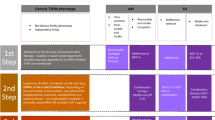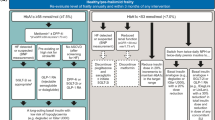Abstract
Frailty is considered a syndrome of decreased reserve and resistance to stressors and is clinically expressed as muscle weakness, poor exercise tolerance, factors related to body composition, sarcopenia and disability. In addition, there is a close relationship between age-related metabolic changes and the occurrence of comorbidities that may in turn lead to frailty.
Even though the downward spiral of frailty is activated more quickly in older persons with type 2 diabetes, it is reversible with appropriate interventions before reaching a high level of severity. The hazard for geriatric patients with type 2 diabetes is that frailty encompasses diverse complications already associated with or caused by diabetes. Frailty is also associated with cognitive impairment, reduced ability to perform activities of daily living and increased expression of inflammatory and coagulation markers that may contribute to the adverse microvascular effects of diabetes. Although glycaemic control remains the main targeting achievement in type 2 diabetes, especially in well-functioning older persons, this is not appropriate for those with frailty. Frail elderly people with type 2 diabetes are a specific group in need of treatment parameters for both initial and maintenance therapy with oral antidiabetic agents. Therefore, the prescription of an antidiabetic agent in such individuals must take into consideration not only the standard goal of lowering hyperglycaemic levels, but also improving the quality of life and life expectancy. The clinical management of this population is currently particularly demanding, requiring special considerations with good medical decision making. Clinical aspects complicating diabetes care in older people include cognitive decline, physical functional decline and frailty. Available oral antidiabetic drugs include insulin secretagogues (meglitinides and sulfonylureas), biguanides (metformin), α-glucosidase inhibitors, thiazolidinediones and inhibitors of glucagon-like peptide 1 (GLP-1) degrading enzyme dipeptidyl peptidase 4. In addition, we will discuss injection treatment with GLP-1 analogues. This review will underline the association between diabetes and some frailty components in old patients and how specific antidiabetic agents may play a specific role in improving outcomes.
Similar content being viewed by others
References
Kim MJ, Rolland Y, Cepeda O, et al. Diabetes mellitus in older men. Aging Male 2006; 9: 139–47
Mazza AD, Morley JE. Update on diabetes in the elderly and the application of current therapeutics. J Am Med Dir Assoc 2007; 8: 489–92
Morley JE, Haren MT, Rolland Y, et al. Frailty. Med Clin North Am 2006; 90: 837–47
Fried LP, Ferrucci L, Darer J, et al. Untangling the concepts of disability, frailty, and comorbidity: implications for improved targeting and care. J Gerontol A Biol Sci Med Sci 2004; 59: 255–63
Morley JE, Kim MJ, Haren MT, et al. Frailty and the aging male. Aging Male 2005; 8: 135–40
Morley JE, Perry HM, Miller DK. Something about frailty. J Gerontol A Biol Sci Med Sci 2002; 57: M698–704
ACCORD Study Group, Gerstein HC, Miller ME, et al. Long-term effects of intensive glucose lowering on cardiovascular outcomes. N Engl J Med. 2011; 364 (9): 818–28
Bremer JP, Jauch-Chara K, Hallschmid M, et al. Hypogly-cemia unawareness in older compared with middle-aged patients with type 2 diabetes. Diabetes Care 2009; 32 (8): 1513–17
Bortz WM II. The physics of frailty JAGS 1993; 41: 1004–8. Hamerman D. Toward an understanding of frailty. Ann Intern Med 1999; 130: 945–50
Abbatecola AM, Paolisso G, Corsonello A, et al. Antidiabetic oral treatment in older people: does frailty matter? Drugs Aging 2009; 26 Suppl. 1: 53–62
Fried LP, Tangen CM, Walston J, et al., Cardiovascular Health Study Collaborative Research Group. Frailty in older adults: evidence for a phenotype. J Gerontol A Biol Sci Med Sci 2001; 56 (3): M146–56
Abbatecola AM, Rizzo MR, Barbieri M, et al. Post-prandial plasma glucose excursions and cognitive functioning in aged type 2 diabetics. Neurology 2006; 67 (2): 235–40
Volpato S, Ferrucci L, Blaum C, et al. Progression of lower-extremity disability in older women with diabetes: the Women’s Health and Aging Study. Diabetes Care 2003; 1: 70–5
Vanitallie TB. Frailty in the elderly: contributions of sarcopenia and visceral protein depletion. Metabolism 2003; 52 (10 Suppl. 2): 22–6
Evans WJ, Paolisso G, Abbatecola AM, et al. Frailty and muscle metabolism dysregulation in the elderly. Biogerontology 2010; 11 (5): 527–36
Park SW, Goodpaster BH, Strotmeyer ES, et al. Decreased muscle strength and quality in older adults with type 2 diabetes: the health, aging, and body composition study. Diabetes 2006; 55 (6): 1813–18
Franceschi C, Bonafe M, Valensin S, et al. Inflammaging: An evoluzinary perspective on immunosenescence. Ann NY Acad Sci 2000; 908: 244–54
Abbatecola AM, Ferrucci L, Grella R, et al. Diverse effect of inflammatory markers on insulin resistance and insulin-resistance syndrome in the elderly. J Am Geriatr Soc 2004; 52 (3): 399–404
Spazzafumo L, Olivieri F, Abbatecola AM, et al. Remodelling of biological parameters during human ageing: evidence for complex regulation in longevity and in type 2 diabetes. Age (Dordr) Epub 2011
Jones SA, Horiuchi S, Topley N, et al. The soluble inter-leukin 6 receptor: mechanisms of production and implication in disease. FASEB J 2001; 15: 43–58
Kawazoe Y, Naka T, Fujimoto M, et al. Signal transducer and activator of transcription (STAT)-induced STAT inhibitor (SSI-1)/Suppressor of Cytokine Signaling 1 (SOCS1) inhibits insulin signal transduction pathway through modulating insulin receptor substrate 1 (IRS-1) phosphorylation. J Exp Med 2001; 193: 263–9
Krebs DL, Hilton DJ. SOCS: Physiological suppressors of cytokine signaling. J Cell Sci 2000; 113: 2813–19
Cappola AR, Xue QL, Ferrucci L, et al. Insulin-like growth factor I and interleukin-6 contribute synergistically to disability and mortality in older women. J Clin Endocrinol Metab 2003; 88 (5): 2019–25
Joya-Galeana J, Fernandez M, Cervera A, et al. Effects of insulin and oral anti-diabetic agents on glucose metabolism, vascular dysfunction and skeletal muscle inflammation in type 2 diabetic subjects. Diabetes Metab Res Rev 2011; 27 (4): 373–82
Perez A, Jacks R, Arora V, et al. Effects of pioglitazone and metformin fixed-dose combination therapy on cardiovascular risk markers of inflammation and lipid profile compared with pioglitazone and metformin monotherapy in patients with type 2 diabetes. J Clin Hypertens (Greenwich) 2010; 12 (12): 973–82
Ferrucci L, Cavazzini C, Corsi A, et al. Biomarkers of frailty in older persons. J Endocrinol Invest 2002; 25: 10–15
Laakso M, Edelman SV, Brechtel G, et al. Decreased effect of insulin to stimulate skeletal muscle blood flow in obese man. A novel mechanism for insulin resistance. J Clin Invest 1990; 85 (6): 1844–52
Abbatecola AM, Chiodini P, Gallo C, et al., Health ABC study. Pulse wave velocity is associated with muscle mass decline: Health ABC study. Age (Dordr) 2012; 34 (2): 469–78
Sinclair AJ, Paolisso G, Castro M, et al., European Diabetes Working Party for Older People. European Diabetes Working Party for Older People 2011 clinical guidelines for type 2 diabetes mellitus. Executive summary. Diabetes Metab 2011; 37 Suppl. 3: S27–38
Brown AF, Mangione CM, Saliba D, et al. Guidelines for improving the care of the older persons with diabetes. J Am Geriatr Soc 2003; 51 (suppl guidelines): S265–80
Cayea D, Boyd C, Durso SC. Individualising therapy for older adults with diabetes mellitus. Drugs&Aging 2007; 24 (10): 851–63
Patel A, MacMahon S, Chalmers J, et al., ADVANCE Collaborative Group. Intensive blood glucose control and vascular outcomes in patients with type 2 diabetes. N Engl J Med 2008; 358 (24): 2560–72
Malaisse WJ. Pharmacology of the meglitinide analogs: new treatment options for type 2 diabetes mellitus. Treat Endocrinol 2003; 2 (6): 401–14
Bailey CJ, Turner RC. Metformin. N Engl J Med 1996; 334 (9): 574–9
Radziuk J, Bailey CJ, Wiernsperger NF, et al. Metformin and its liver targets in the treatment of type 2 diabetes. Curr Drug Targets Immune Endocr Metabol Disord 2003; 3 (2): 151–69
American diabetes Association. Standards of medical care in diabetes-2011. Diabetes Care 2011; 34 Suppl. 1: S11–61
Nathan DM, Buse JB, Davidson MB, et al. Medical management of hyperglycemia in type 2 diabetes: a consensus algorithm for the initiation and adjustment of therapy: a consensus statement of the American Diabetes Association and the European Association for the Study of Diabetes. Diabetes Care 2009; 32 (1): 193–203
Johnson JA, Majumdar SR, Simpson SH, et al. Decreased mortality associated with the use of metformin compared with sulfonylurea monotherapy in type 2 diabetes. Diabetes Care 2002; 25: 2244–8
Chapman IM. Anorexia of aging. Clin Geriat Med 2007; 23 (4): 735–56
Tamura Y, Araki A, Chiba Y, et al. Postprandial reactive hypoglycemia in an oldest-old patient effectively treated with low-dose acarbose. Endocr J 2006; 53 (6): 767–71
Pratley RE, Gilbert M. Clinical management of elderly patients with type 2 diabetes mellitus. Postgrad Med 2012; 124 (1): 133–43
Erdmann E, Charbonnel B, Wilcox RG, et al. PROactive investigators Pioglitazone use and heart failure in patients with type 2 diabetes and pre-existing cardiovascular disease: data from the PROactive study (PROactive 08). Diabetes Care 2007; 30 (11): 2773–8
Kahn SE, Zinman B, Lachin JM, et al. Diabetes Outcome Progression Trial (ADOPT) Study Group Rosiglitazone-associated fractures in type 2 diabetes: an Analysis from A Diabetes Outcome Progression Trial (ADOPT). Diabetes Care 2008; 31 (5): 845–51
Loke YK, Singh S, Furberg CD. Long-term use of thiazolidinediones and fractures in type 2 diabetes: a meta-analysis. CMAJ 2009; 180 (1): 32–9
Linnebjerg H, Kothare PA, Seger M, et al. Exenatide-pharmacokinetics, pharmacodynamics, safety and tolerability in patients ≥75 years of age with type 2 diabetes. Int J Clin Pharmacol Ther 2011; 49 (2): 99–108
Buse JB, Rosenstock J, Sesti G, et al., LEAD-6 Study Group. Liraglutide once a day versus exenatide twice a day for type 2 diabetes: a 26-week randomised, parallel-group, multinational, open-label trial (LEAD-6). Lancet 2009; 374 (9683): 39–47
Monami M, Iacomelli I, Marchionni N, et al. Dipeptydil peptidase-4 inhibitors in type 2 diabetes: a meta-analysis of randomized clinical trials. Nutr Metab Cardiovasc Dis 2010; 20 (4): 224–35
DeFronzo RA, Burant CF, Fleck P, et al. Efficacy and tolerability of the DPP-4 inhibitor alogliptin combined with pioglitazone, in metformin-treated patients with type 2 diabetes. J Clin Endocrinol Metab 2012; 97 (5): 1615–22
Barzilai N, Guo H, Mahoney EM, et al. Efficacy and tolerability of sitagliptin monotherapy in elderly patients with type 2 diabetes: a randomized, double-blind, placebo-controlled trial. Curr Med Res Opin 2011; 27 (5): 1049–58
Author information
Authors and Affiliations
Corresponding author
Rights and permissions
About this article
Cite this article
Abbatecola, A.M., Olivieri, F., Corsonello, A. et al. Frailty and Safety. Drug Saf 35 (Suppl 1), 63–71 (2012). https://doi.org/10.1007/BF03319104
Published:
Issue Date:
DOI: https://doi.org/10.1007/BF03319104




